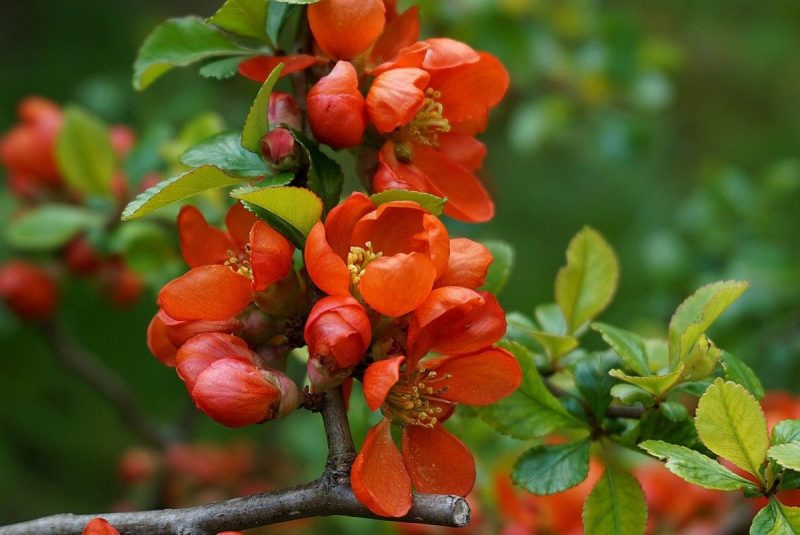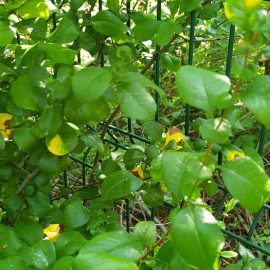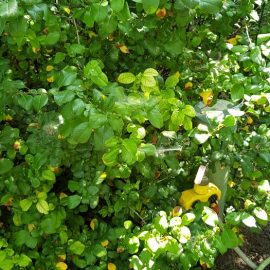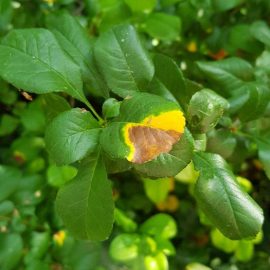Japanese quince, planting guide and care work

The Japanese quince (Chaenomeles japonica) is a species of flowering shrubs in the Rosaceae family. It grows to a height of 1 m and forms thorny shoots. The leaves are oval, wide, 3-5 cm, with stipules. They are often fasciculate. Flowering takes place early, in March-April, before the full development of the foliage. The flowers are sessile, red in color, growing in bouquets of 2-4 blooms or solitary. The fruits are small (4-5 cm in size), globular, yellow. They have a specific scent.
It can be planted alone, in groups, or in the form of hedges. They can be found in parks and gardens, being appreciated for the beauty of their flowers and the early flowering. The fruits of Japanese quince are edible, and sometimes used in various dishes.




Species and varieties
Chaenomeles lagenaria sin. Chaenomeles speciosa is a species native to East Asia. It is more vigorous than the previous species and grows up to over 2 m in height. The branches grow scattered and have thorns. The leaves have a larger limb, are dark green, glossy. The flowers are 3-4 cm in size, are red-pink, and develop in March-April. The fruits are larger and have a more elongated shape.
Chaenomeles x superba is a hybrid species between C. japonica and C. lagenaria, from which numerous ornamental cultivars have been obtained, among which:
‘Crimson and Gold’ – with dark red flowers with golden anthers.
‘Hollandia’ – with intense red flowers.
‘Simonii’ – with semi-double, red flowers.
‘Pink Lady’ – with dark pink flowers.
‘Nivalis’ – with white flowers.
Environmental conditions
Light. It likes both sunny and partially shaded places.
Temperature. They are frost-resistant species. However, they are more suitable for lowland areas.
Soil. They can grow in different types of soil, with the exception of the strongly calcareous or compact ones.
Watering
Watering should be done regularly to keep the soil moist, but it can also withstand drought.
Fertilization
To stimulate growth and flowering, a fertilizer for decorative shrubs or flowering plants should be applied.
Recommended products
-
You can find products on a different store
Change Store -
You can find products on a different store
Change Store -
You can find products on a different store
Change Store -
You can find products on a different store
Change Store -
You can find products on a different store
Change Store -
You can find products on a different store
Change Store -
You can find products on a different store
Change Store -
You can find products on a different store
Change Store -
You can find products on a different store
Change Store -
You can find products on a different store
Change Store -
You can find products on a different store
Change Store -
You can find products on a different store
Change Store -
You can find products on a different store
Change Store -
You can find products on a different store
Change Store -
You can find products on a different store
Change Store -
You can find products on a different store
Change Store -
You can find products on a different store
Change Store -
You can find products on a different store
Change Store -
You can find products on a different store
Change Store -
You can find products on a different store
Change Store -
You can find products on a different store
Change Store -
You can find products on a different store
Change Store -
You can find products on a different store
Change Store -
You can find products on a different store
Change Store
Pruning
It can easily withstand shape correction cuts, which are done in early spring, before entering the vegetative growth period.
Recommended products
-
You can find products on a different store
Change Store -
You can find products on a different store
Change Store -
You can find products on a different store
Change Store -
You can find products on a different store
Change Store -
You can find products on a different store
Change Store -
You can find products on a different store
Change Store -
You can find products on a different store
Change Store -
You can find products on a different store
Change Store -
You can find products on a different store
Change Store -
You can find products on a different store
Change Store -
You can find products on a different store
Change Store -
You can find products on a different store
Change Store -
You can find products on a different store
Change Store -
You can find products on a different store
Change Store -
You can find products on a different store
Change Store -
You can find products on a different store
Change Store -
You can find products on a different store
Change Store -
You can find products on a different store
Change Store -
You can find products on a different store
Change Store -
You can find products on a different store
Change Store -
You can find products on a different store
Change Store -
You can find products on a different store
Change Store -
You can find products on a different store
Change Store -
You can find products on a different store
Change Store
Diseases and pests
Diseases that can affect the Japanese quince are fire blight and brown spot (which manifests on the leaves and fruits). The Japanese quince can be affected by the San Jose scale.
Planting
It can be done in spring or autumn, during the vegetative dormancy period, at temperatures above 5° C, if the soil is not frozen and there is no danger of frost. Be sure to purchase planting material from authorized nurseries. Immediately after planting, the soil has to be well-trodden and watered abundantly. After that, the soil must be kept damp.
Propagation
The Japanese quince can be propagated through seeds, cuttings, layering, root suckers, or grafting.
- the seeds should be sown in spring, after layering of 1-2 months.
- cuttings are harvested in June-July. The cuttings should then be left to take root in a solution containing rooting hormones.
- layering is performed in spring (mound or simple).
- root suckers should be removed in late autumn or early spring, being careful not to damage the roots.
- grafting should be done on plant roots obtained from cuttings, not seeds. Grafting is performed in winter.
Recommended products
-
You can find products on a different store
Change Store -
You can find products on a different store
Change Store -
You can find products on a different store
Change Store -
You can find products on a different store
Change Store -
You can find products on a different store
Change Store -
You can find products on a different store
Change Store -
You can find products on a different store
Change Store -
You can find products on a different store
Change Store -
You can find products on a different store
Change Store -
You can find products on a different store
Change Store -
You can find products on a different store
Change Store -
You can find products on a different store
Change Store -
You can find products on a different store
Change Store -
You can find products on a different store
Change Store -
You can find products on a different store
Change Store -
You can find products on a different store
Change Store -
You can find products on a different store
Change Store -
You can find products on a different store
Change Store -
You can find products on a different store
Change Store -
You can find products on a different store
Change Store -
You can find products on a different store
Change Store -
You can find products on a different store
Change Store -
You can find products on a different store
Change Store -
You can find products on a different store
Change Store
In addition:
- the Japanese quince species produce many root suckers, especially C. lagenaria.
- they are resistant to smoke and pollution.
- they can also be kept in pots or garden pots.
- they are suitable for miniature growing, in the form of bonsai trees.
- in some countries, it can be grown at an altitude of up to 1400 m.


















































































































































































































































































































































































































































